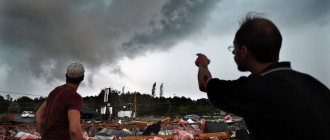What is a phenomenon?
A tornado or tornado is an atmospheric vortex that occurs in thunderclouds and extends to the earth's surface. The air mass rotates at incredible speed, forming a funnel. From the cloud, the internal flows of the funnel extend towards the ground, and the external flows rise. The result is an area where the air is thin.
Objects that enter this area and have a sufficient level of pressure inside them usually explode under the influence of the pressure difference. In this context, such objects primarily mean closed buildings.
The described natural phenomenon has the following characteristics:
- shape - very different (cone-, barrel-, glass-, horn-shaped, hourglass-shaped, writhing cord, but most often funnel-shaped);
- period of existence – from a couple of minutes to several hours;
- difference between central and peripheral pressure – up to 200 mb;
- travel speed – up to 1000 km/h;
- direction of movement - counterclockwise in the northern hemisphere, clockwise in the southern hemisphere;
- destruction area – up to 3 km;
- the diameter of the crater is from several tens of meters to 2 km;
- color is different, determined by the illumination of the captured space, air humidity, and the location of the Sun.
An atmospheric vortex located in front of the Sun looks darker, and if the Sun is behind the eyewitness, it looks lighter. When the air is saturated with moisture, a tornado is more visible. A vortex that occurs at low air and soil humidity is considered the most dangerous, since it can be completely transparent and unnoticeable. It is noticed only when objects enter the air flow. A tornado that appears during a dust storm or heavy rain is also dangerous: it is difficult to notice it in a timely manner.
Due to global climate change, tornadoes began to be recorded in regions where this phenomenon was not previously typical. If you look at latitudes, tornadoes are most often observed in the band between 45 and 60°, but on the North American continent the zone of occurrence extends to 30°. The United States suffers from natural disasters most often; about 800 whirlwinds are recorded in the country every year. Therefore, in many states, private homes are equipped with underground shelters. In 1965, US weather services recorded 37 simultaneous tornadoes in six states.
In the spring and summer months, when air temperatures are consistently high, tornadoes appear several times more often than in the cold season. Air vortices are most active in May and June. They appear exclusively during thunderstorms in the daytime and evening. Tornadoes are rarely observed at night.
The following are interesting facts about tornadoes:
- The strength of the wind flow is such that small and light objects caught in the funnel pierce through the trees and walls of buildings encountered along the way.
- There have been cases when buildings were not destroyed, but were entirely transported over considerable distances or turned around on the foundation.
- Some people managed to survive, even remain unharmed, while in the center of the vortex. There is a calm zone inside the air column, but it is difficult to breathe there, since the air is rarefied.
- Tornadoes often carry unusual objects over considerable distances, which then fall to the ground. Eyewitnesses talk about rains of frogs, insects, fish, coins and other things.
- Once, a tornado lifted a train weighing more than 80 tons above the ground and threw it 40 meters.
- There was a case when a whirlwind was unable to lift a well-fixed steel bridge more than 70 meters long from the ground. Then he twisted it into a spiral.
What is a tornado and why is it dangerous?
Tornadoes are one of the most dangerous and destructive natural phenomena, annually claiming hundreds of lives across the planet. The reasons for the appearance of these giant whirlwinds have been known to people since ancient times, but so far no one has learned to pacify them.
Scientists believe that the number of tornadoes is growing noticeably every year, which is associated with general climate change on the planet and the deterioration of the environmental situation.
What does the word "tornado" mean? Why does a tornado occur and what is it? How dangerous is a tornado for people? What's inside a tornado? What is stronger: a tornado or a tornado?
What does the word "tornado" mean?
The largest number of tornadoes were seen in North America, which is where their name comes from. The term “tornado” translated from Spanish means “rotating” - this is what the Spaniards called these whirlwinds when they arrived on the mainland after the discovery of the New World.
In the Russian language, the toponym “smerch” is more often used, which comes from the Old Russian smirch, or smarch, which translates as “cloud”.
Why does a tornado occur and what is it?
A tornado is a vortex in the atmosphere that develops inside a cumulus cloud and gradually descends to the ground in the form of a column up to 400 meters wide at the base. In some cases, its diameter on land can reach 3 kilometers or more, and on water this value usually does not exceed 40 meters. There is a huge difference in pressure between the inside and outside of a tornado - sometimes it is so great that objects falling inside are simply torn apart.
The causes of tornadoes have not been reliably established, but it is believed that they occur in cases where warm, moist air comes into contact with a cold, dry “dome” that has arisen over cold areas of land or ocean. During contact, heat is released, after which the heated air rises, thereby creating an area of rarefaction.
Warm air from the cloud and underlying cold air are drawn into this zone, resulting in the release of significant energy and the formation of a vortex. According to some estimates, the speed of air movement in it can reach 1300 km/h, while the vortex itself moves on average at a speed of 20 to 60 km/h.
Tornadoes come in different shapes and sizes. The most common are whip-like, thin and smooth, resembling a whip or scourge in appearance. Less common are vague ones, similar to thick clouds near the ground, and composite ones, consisting of two or three vortices. During volcanic eruptions, fire tornadoes are often observed, spreading fire over tens of kilometers. In deserts, there are some kind of analogues of tornadoes - dust or sand whirlwinds, but, as a rule, their diameter does not exceed 3 meters.
How dangerous is a tornado for people?
After contacting the ground, tornadoes leave behind widespread destruction. They lift into the air and carry over vast distances not only garbage, but also large objects, including trees, houses and vehicles. It is a rare person who finds himself in the center of a tornado and is able to survive.
People who are in the immediate vicinity of a tornado also suffer, because debris from buildings, beams, and slates flying from it can seriously injure and even kill.
What's inside a tornado?
A tornado is still a little-studied phenomenon, but scientists believe that in the center of the vortex there is an area of low pressure that does not allow outside air to fill the interior of the tornado. It is likely that there are vertical air currents inside, although such phenomena have not been reliably proven.
The suction force of a tornado is explained by the high turbulence of the air column and the vertical component of the speed, which rapidly changes during movement.
What is stronger: a tornado or a tornado?
Tornado and tornado are synonymous words used differently in different regions of the globe. The strongest whirlwind was recorded in 1999 in the US state of Texas, when a powerful funnel swept across the earth at a speed of about 500 km/h and destroyed everything in its path.
If we talk about size, the 2013 tornado in Oklahoma is considered the largest - it moved at a speed of 485 km/h and covered an area of about 4.2 km. One of the most famous tornado hunters, Tim Samaras, died in this hurricane, along with his son and friend Carl Young.
How does a tornado or tornado form?
Scientists are well aware of what a tornado is; research has been actively conducted for decades. But, despite the fact that the structure of a tornado has been well studied, it has not yet been possible to reveal the exact reasons for the formation of tornadoes. All we can say for sure is that the ominous funnel is one of the options for air movement.
The thundercloud from which the funnel originates is located at an altitude of 3–4 km from the earth’s surface. At this height the axis of air flows is located: powerful updrafts and sharp and strong gusts of wind are noted.
The warm, moist air mass that forms the cloud collides with a cold current that forms over land or water. During a collision, moisture condenses and raindrops form. The warm air mass rushes upward, where it creates an area of rarefaction. Both the warm air of the cloud and the cold air located under the cloud are drawn into this area.
The process is accompanied by the release of a large amount of energy, sufficient to form a funnel directed downward, drawing in everything that can come off the ground. Having reached the ground, the vortex does not stay in one place, but continuously moves, absorbing cold surface air. There is usually no precipitation, with light rain falling on rare occasions.
When the supply of cold and warm air flows dries up, the “pipe” begins to narrow. Soon she lifts off the ground and dissolves into the cloud from which she came.
What is the difference between a tornado and a tornado?
Sometimes you can hear that a tornado and a tornado are two similar, but still different phenomena. Actually this is not true. The term tornado is of ancient Russian origin. Previously, it meant “black cloud.”
The word "tornado" is Spanish. The verb "tornar" means "to twirl, twist, rotate" in this language. Some sources use the term “thrombus”, which is derived from the Italian word “pipe”. Indeed, visually a tornado looks like a pipe connecting the earth with the heavens.
Classification of tornadoes
The following types of tornadoes are distinguished:
- Scourge-like - the most frequently observed, least destructive, often observed over water. The funnel is smooth-walled, narrow, sometimes meanders:
- Vague - wide, similar to a cloud descending to the ground and spinning. This is a strong tornado, capturing a significant area of the earth's surface, rushing at incredible speed:
- Composite - consisting of several “cords” moving around the main “pipe”. Tornadoes of this type are the most destructive, as they attack several areas of the territory at once:
- Fire tornadoes emerge from clouds caused by either a severe natural fire or a volcanic eruption. They are dangerous because they contribute to the spread of fire over many kilometers:
- Waterspouts occur over the ocean, sea, or less often lake surface, when the water is cold and the air above it is warm:
- Zemlyanoy is a rare species that appears as a result of a serious natural disaster, most often an earthquake. Typically thin and curved, with the radius of the walls widening closer to the ground. In the central part of the column there are lumps of soil swirling, below there is a mass of mud:
- A snow tornado is a consequence of a severe winter snowstorm:
- Sandy is a rare and unique species due to its origin. The occurrence of a tornado is noted not in the cloud layer, but in the ground part. The sun's rays heat the sand so that the pressure in this area decreases, and air masses flow into this area. The sand, under the influence of the wind, begins to rotate, forming a large funnel capable of movement and long-term existence:
There is a classification of tornadoes based on the strength of the damaging factors. The following types of vortices are distinguished:
- Weakly destructive (speed up to 30 m/s). Possible damage to roofs, fences, and trees.
- Moderately destructive (up to 50 m/s). Ripping off roofs, overturning cars.
- Significantly destructive (up to 70 m/s). Collapsing small buildings, overturning large vehicles, uprooting trees.
- Strong (up to 90 m/s). Destroying the walls of buildings, lifting cars, trains, watercraft.
- The strongest (up to 115 m/s). Destroying and lifting large buildings, picking up and throwing vehicles, and other large objects.
- Super strong (up to 145 m/s). Huge construction and transport projects are transported over long distances at tremendous speed.
- Completely destructive (speed from 145 m/s). Scattering into pieces everything that gets in their way.
Tornado is a dangerous phenomenon
The tornado still intrigues scientists with its mysterious phenomena. In essence, it is just an atmospheric vortex . But it has such power that, for example, in 1917 it managed to kill 110 people in the United States in just over 7 hours.
There are many unusual facts about the tornado:
- Its development occurs in a spiral directed vertically, mainly under cumulus clouds. The tornado descends down in the form of a funnel, the lower part of which is greatly narrowed.
- Such a powerful vortex appears in the region of the tropospheric front , where there is a boundary in the lower layer of the atmosphere, the function of which is to separate air masses with different temperature conditions, air humidity and wind speed. Here the atmosphere is unstable, fluctuating due to the presence of cold air and warm air, and as a result, numerous vortices with rapid rotation are formed.
- A tornado is born mainly during the period when cold air fronts appear - in autumn or spring .
- The diameter of a tornado can be from ten to hundreds of meters , height - up to 10 km .
- Its color is dark.
- The whole danger of a tornado is that it contains such an amount of energy that is equal to the energy of an atomic bomb .
- The air rotates counterclockwise , the pressure drops here, so everything that gets inside along the path of such a vortex is torn into pieces.
- Scientists could not reveal all the secrets of the tornado, but they determined for sure: a so-called eye is formed in the middle, where there is no movement . However, there is an energetic rotation of the air mass around it, and its speed increases as the tornado moves.
Methods of protection against a tornado
Unfortunately, knowing what a tornado is, experts cannot yet predict its occurrence in advance. The population receives a warning about the danger 10–15 minutes before the disaster. But even this time is enough to survive a tornado.
Speaking about the danger a tornado poses to human life, the first thing we need to note is the destruction of the home and the formation of rubble. If the building is large, then finding people under the rubble is problematic. The second danger is rising into the air and hitting the ground. It is virtually impossible to survive in this case.
There is only one option to escape from a tornado - going to an underground shelter. A tornado is a land phenomenon, so the safety zone is objects below ground level. The best protection against a tornado is going to the subway, basement, or underground garage. If the whirlwind is not strong, then you can take refuge in a strong brick or concrete building.
If on land they find salvation in a dungeon, then when a terrible sinkhole appears over the sea, the sailors can only rely on the miracle and strength of the ship.
The rules of conduct during a disaster are as follows:
- You cannot stay in a car or bus (for a vortex, transport is a favorite target);
- It is prohibited to run out of shelter into open spaces;
- if there is nowhere to hide, and the vortex overtakes you, then you need to run not forward (vortexes often move faster than a car), but to the side;
- A good option for action in an open space is to find a hole in the ground, lie down in it, curl up, and cover your head with your hands.
The following three are considered the strongest and most destructive tornadoes in human history:
- Destroyed the town of Wichita Falls (Texas) in April 1958. This tornado is recorded in the Guinness Book as the most powerful, with crazy wind speeds (from 450 km/h).
- The destruction of Manikganj, a densely populated region of Bangladesh in April 1989:
This tornado is considered the most terrible and disastrous in the history of civilization. 1,300 people were killed and more than 12,000 were injured. - Hit three US states in March 1925. This tornado is the largest in history, it consisted of eight funnels.
There are other famous cases of terrifying disasters. Great destruction and numerous casualties were left after tornadoes swept through Bangladesh in 1969, Oklahoma in May 2013, and the Yangtze Valley in China in June 2015.
Consequences of tornadoes and tornadoes
- A tornado itself is considered dangerous. If a person is pulled into a tornado in an open area, he can die simply from falling from a great height. But still, the main danger of a tornado for humans lies in objects and buildings captured by the whirlwind and flying over people. In addition, in populated areas, a tornado can lead to the spread of fire and malfunction of energy communications, which also threatens human life.
- If you believe the statistics, an average of 400 people die from tornadoes every year. On March 18, 1925, approximately 700 people died from this phenomenon in the US states of Missouri, Tennessee, Illinois and Kentucky. The 1957 tornado in North Dakota was able to destroy 500 buildings and caused a loss of $15 million. This tornado overturned cranes, lifted carriages and cars into the air, and destroyed buildings.
Read also: Lack of fat is dangerous to health
What is the difference between a tornado and a tornado?
Tornadoes and tornadoes are one and the same phenomenon. Some call surface formations the first word, and above-ground formations the second. In reality there is no difference. They prefer to call the same atmospheric vortex a tornado in Russian-speaking countries, and a tornado in the USA. By the way, the Spanish word "tornado" means "rotation".
A tornado is an amazing, amazing phenomenon. Spiral moving air becomes a formidable element, causing enormous damage. The phenomenon has not yet been studied so well that meteorologists can predict or prevent it in advance.










